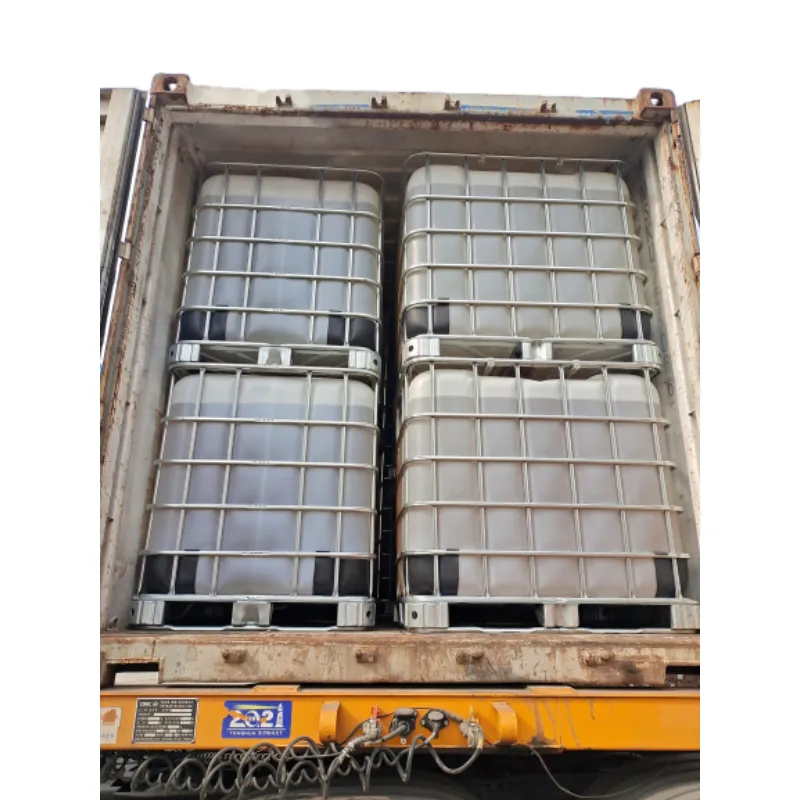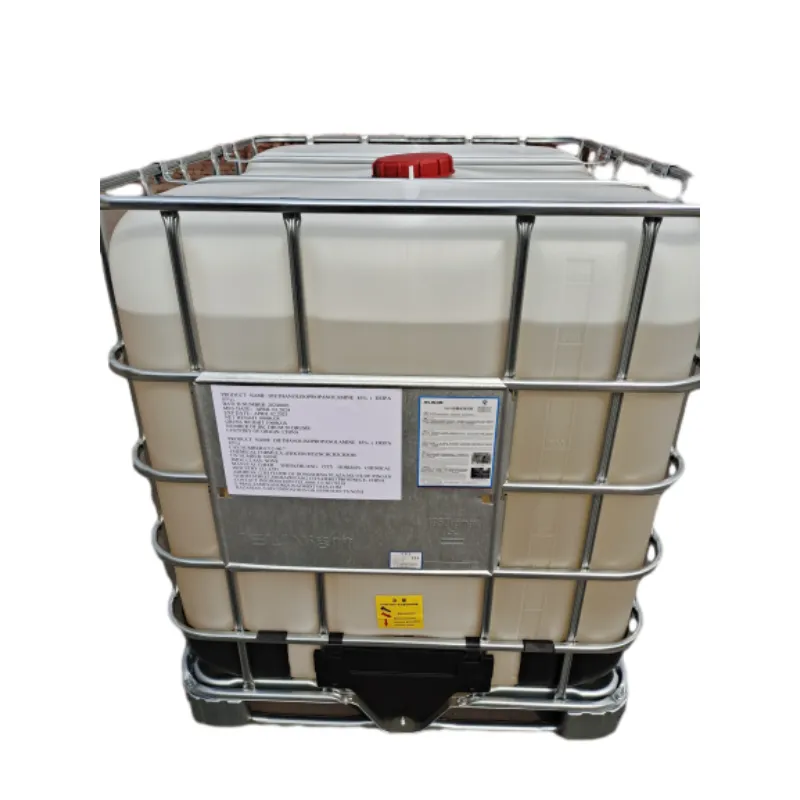
Diethanolisopropanolamine DEIPA 85% Cement Grinding Aid
Diethanolisopropanolamine (DEIPA): real-world specs, use cases, and buyer notes from the field
If you work around cement mills, personal care labs, or ag formulators, you’ve probably heard the name Diethanolisopropanolamine more often lately. To be honest, I first met it in a grinding-aid pilot line where a plant manager told me, “DEIPA made our 28-day strength less of a dice roll.” Since then, I’ve followed how this amino alcohol has moved from niche to mainstream—quietly, but decisively.

Why it’s trending
In construction, Diethanolisopropanolamine is prized as a cement grinding aid and strength enhancer (early and late). In personal care, it’s a neutralizer/buffering agent with good clarity in surfactant systems. Agriculture folks use it to form stable salts with acids in foliar feeds. The through-line? It’s efficient, relatively low odor, and increasingly viewed as a flexible alternative to TEA or other alkanolamines.
Typical product specifications (tech grade, indicative)
| Appearance | Clear to pale-yellow liquid |
| Purity (DEIPA) | ≥ 85% (HPLC; real-world use may vary) |
| Water | ≤ 0.5% (Karl Fischer, ASTM E203/ISO 760) |
| Color | ≤ 200 APHA (ASTM D1209) |
| Amine value | ≈ 500–600 mgKOH/g (titration) |
| Viscosity | ≈ 150–300 mPa·s at 25°C (ASTM D445) |
| Packaging | 200 kg drums / 1000 kg IBCs |
| Shelf life | 12–24 months unopened; store cool, dry, sealed |

Process flow (what most plants actually do)
- Materials: isopropanolamine backbone plus controlled alkoxylation (often ethylene oxide); deionized water for finishing.
- Methods: base-catalyzed alkoxylation at ≈ 80–120°C, 2–5 bar; aging to complete conversion; vacuum stripping for residuals; polishing filtration.
- Testing standards: purity by HPLC; water by ASTM E203/ISO 760; color ASTM D1209; viscosity ASTM D445; residual EO/PO by GC (method internal).
- Quality system: typically ISO 9001:2015; REACH and RoHS compliance where required.
- Service life in application: in cement, performance gain persists throughout cement shelf life; in personal care, neutralization stability is formulation-dependent.
Where it’s used (and why customers keep it)
Diethanolisopropanolamine is common in:
- Cement grinding aids and strength enhancers (ASTM C465 compliant processing additions). Typical uplift I’ve seen: +3–8% 1‑day and +5–10% 28‑day compressive strength vs. baseline, measured per ASTM C109. - Personal care: pH adjustment in surfactant systems; tends to give clearer solutions than some alkanolamines. - Agriculture: amine salts for foliar nutrition and adjuvants; decent solubility and buffering capacity.Advantages? Good grind efficiency, lower dosage than legacy blends in many mills, and—surprisingly—stable color if you store it properly. Many customers say odor is manageable.

Vendor snapshot (indicative, compare what matters)
| Vendor | Purity | Certifications | Lead time | Packaging | Notes |
|---|---|---|---|---|---|
| Tenger Chemical (Origin: 3-2-501, North Courtyard, West District, Jiuli Courtyard, Yuhua District, Shijiazhuang, Hebei, China) | ≥ 85% | ISO 9001; REACH-ready | ≈ 10–15 days | 200 kg drums / 1000 kg IBCs | Good tech support for cement trials |
| Vendor A (regional) | ≈ 80–85% | ISO 9001 | 2–3 weeks | Drums only | Budget-friendly |
| Vendor B (global) | ≥ 88% | ISO 9001/14001 | 3–5 weeks | Drums / IBCs / bulk | Premium pricing, wide logistics |
Customization and testing
- Tailored purity windows (e.g., 80%, 85%, 88%) for cost-performance balance.
- Additive blends: Diethanolisopropanolamine + glycols or TEA for specific clinker profiles.
- QC pack: COA with HPLC chromatogram, APHA color, KF moisture, and amine value.
Two quick case notes
APAC cement producer swapped in Diethanolisopropanolamine at 0.03% on cement. Mill throughput rose ~4%, 28‑day strength +7% vs. baseline (ASTM C109). They kept it. In personal care, a shampoo lab used it to hit pH 6.2 with clearer appearance than previous neutralizer—small win, but noticeable on shelf.

Compliance and safety
Look for ISO 9001:2015 quality systems, REACH registration where applicable, and processing-addition conformance to ASTM C465 for cement. Handle with standard amine PPE; store sealed to avoid CO2 pick-up and color drift.
References
- ASTM C109/C109M — Standard Test Method for Compressive Strength of Hydraulic Cement Mortars.
- ASTM C465 — Standard Specification for Processing Additions for Use in the Manufacture of Hydraulic Cements.
- ASTM D1209 — Standard Test Method for Color of Clear Liquids (Platinum-Cobalt Scale).
- ASTM E203 / ISO 760 — Water Content by Karl Fischer Titration.
- ISO 9001:2015 — Quality management systems — Requirements; EN 197‑1 — Cement — Composition, specifications and conformity criteria.
-
What Is a Food Additive? Global Insights, Applications & Future TrendsNewsNov.24,2025
-
968 Sweetener: The Modern Solution for Health-Conscious SweeteningNewsNov.23,2025
-
Discover the Benefits and Uses of 965 Sweetener (Erythritol) | Tenger ChemicalNewsNov.23,2025
-
961 Sweetener - A Next-Gen Sugar Alternative for Health and IndustryNewsNov.23,2025
-
Understanding 960 Sweetener: The Modern Sugar Alternative for Health and IndustryNewsNov.22,2025
-
Everything You Need to Know About 955 950 Sweeteners – Benefits, Uses, and TrendsNewsNov.22,2025
-
953 Sweetener: Global Insights, Applications, and Future TrendsNewsNov.21,2025
Hebei Tenger Chemical Technology Co., Ltd. focuses on the chemical industry and is committed to the export service of chemical raw materials.
-

view more DiethanolisopropanolamineIn the ever-growing field of chemical solutions, diethanolisopropanolamine (DEIPA) stands out as a versatile and important compound. Due to its unique chemical structure and properties, DEIPA is of interest to various industries including construction, personal care, and agriculture. -

view more TriisopropanolamineTriisopropanolamine (TIPA) alkanol amine substance, is a kind of alcohol amine compound with amino and alcohol hydroxyl, and because of its molecules contains both amino and hydroxyl. -

view more Tetramethyl Thiuram DisulfideTetramethyl thiuram disulfide, also known as TMTD, is a white to light-yellow powder with a distinct sulfur-like odor. It is soluble in organic solvents such as benzene, acetone, and ethyl acetate, making it highly versatile for use in different formulations. TMTD is known for its excellent vulcanization acceleration properties, which makes it a key ingredient in the production of rubber products. Additionally, it acts as an effective fungicide and bactericide, making it valuable in agricultural applications. Its high purity and stability ensure consistent performance, making it a preferred choice for manufacturers across various industries.





